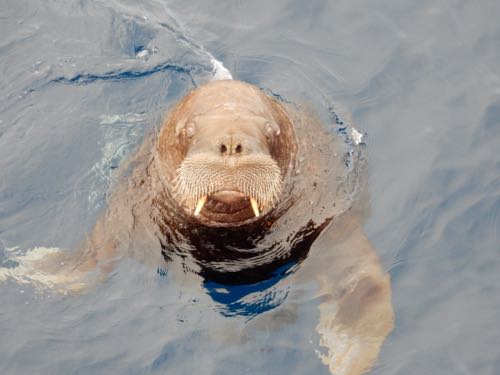Shortly before lunch today we were visited by a juvenile walrus. The young walrus, determined by very small teeth, short whiskers, and smaller body size, playfully swam around the fantail of the boat; at one point even making grunty walrus sounds. There were plenty of opportunities for photos as the walrus gracefully glided through the water, surfaced, and then swam some more. Although its poor vision likely prevented the young walrus from seeing all of the details, it did appear to be curious about the large red object floating in its midst.
We are in very deep water right now - around 2100 meters; likely beyond the diving range of a walrus - and we were concerned over how the young walrus would fare so far from its main food source of clams and other mollusks. One possibility is that the walrus will get on an ice flow and move farther south. This also drives home the potential effects of climate-change-induced ice melt on marine mammals. Normally, deep ocean areas would be covered by ice, and animals such as walruses would be much less likely to venture into areas where they are challenged to find sufficient quantities of food.
This was such a beautifully graceful creature, and it was difficult to pull ourselves away from the beguiling show.
 A visit from a curious young walrus
A visit from a curious young walrus
 A visit from a curious young walrus
A visit from a curious young walrus
 A visit from a young walrus.
A visit from a young walrus.
 A visit from a curious young walrus
A visit from a curious young walrus
PolarConnect Event August 8th
Make plans to "attend" the PolarConnect event on August 8th at 6 PM EDT/2 PM ADT. The event is free, but you will need to register and obtain an access code. Details on registration will be forthcoming. This will be a great opportunity to ask questions about the expedition and speak with some of the science teams!
Question and Answer
What is the normal size range of adult walruses? Is there a difference between the sizes of males and females?


Comments